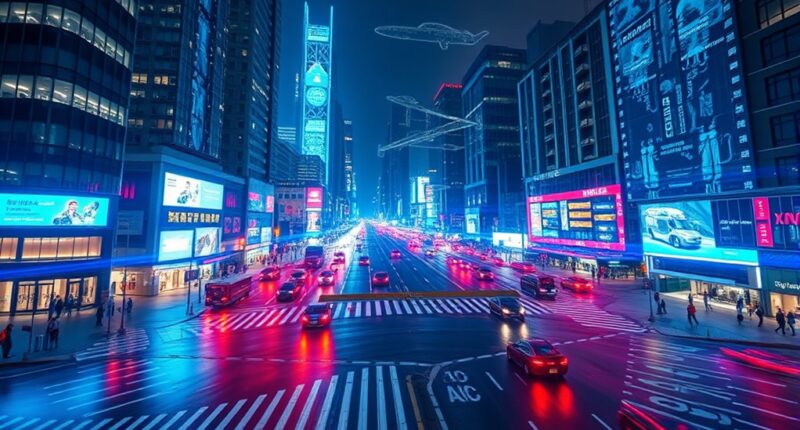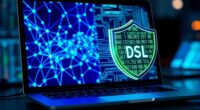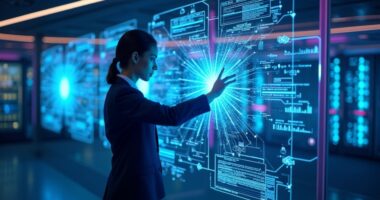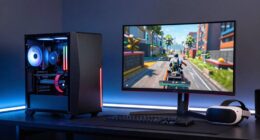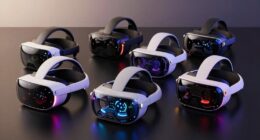Digital twins for cities enable you to create dynamic, real-time virtual models of urban traffic systems. By integrating data from IoT sensors, cameras, and vehicles, you can monitor traffic flow and identify congestion patterns instantly. This technology allows you to simulate different scenarios, optimize traffic signals, and improve overall mobility. If you want to explore how these innovative solutions can transform transportation planning and boost efficiency, there’s more to discover beyond this overview.
Key Takeaways
- Digital twins integrate real-time traffic data from sensors and cameras to simulate current urban traffic conditions accurately.
- They enable scenario testing for traffic management strategies, such as signal timing adjustments and route diversions.
- Continuous monitoring allows for proactive congestion detection and automated responses like dynamic routing.
- Virtual models help city planners visualize traffic flow impacts of infrastructure changes before implementation.
- Real-time simulations support emergency response planning and optimize transportation efficiency across the city.
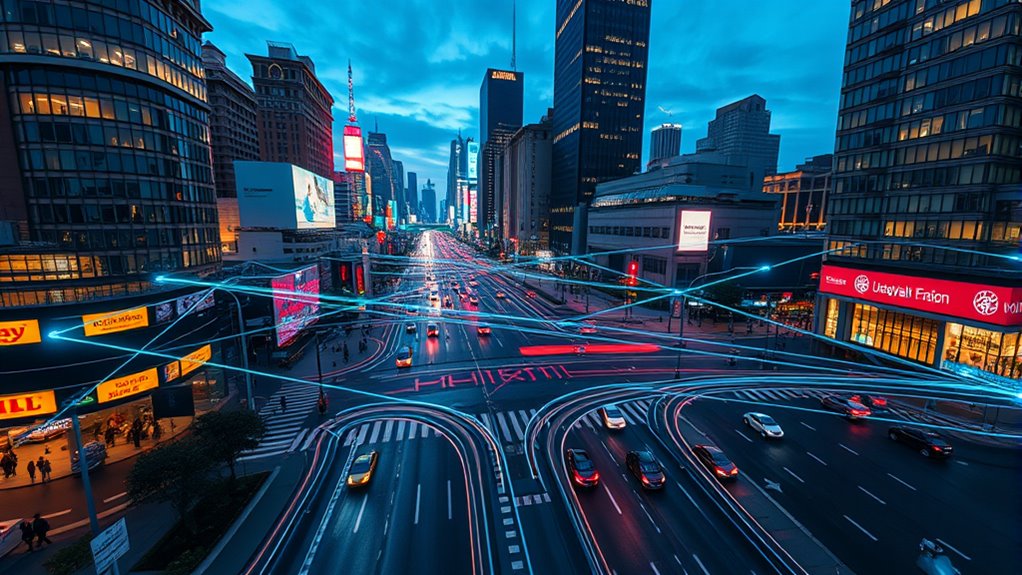
Digital twins are transforming urban management by creating extensive, real-time virtual models of cities. These digital replicas integrate data from streets, utilities, buildings, and other city infrastructure into a single, visual platform that updates constantly. As a city official or planner, you can see a holistic view of your urban environment, which helps align information across departments. This reduces misunderstandings and fosters better collaboration, making it easier to plan and respond to issues. With 3D visualization capabilities, you can assess how proposed changes might impact the environment before any physical work begins, giving you a clearer picture of potential outcomes. This feature also allows you to test scenarios—like infrastructure conflicts or emergency access routes—within the digital space, minimizing risks and costly mistakes in real life. Converting abstract plans into tangible digital models enhances planning accuracy, ensuring your projects are more efficient and effective.
Digital twins provide real-time 3D city models for better planning, collaboration, and risk management.
The real power of digital twins lies in their ability to process continuous data streams. IoT sensors scattered throughout the city, drones capturing real-time imagery, vehicles, buildings, and even citizens contribute to a constant flow of information. This data is combined with historical and synthesized data to provide immediate insights. You can monitor traffic flow, pollution levels, and infrastructure health all at once, enabling rapid responses to emerging issues. Advanced analytics and AI further boost your ability to interpret this data, revealing patterns and predicting future trends. For example, if congestion is building in a certain area, the system can suggest alternative routes or trigger traffic management strategies automatically, enhancing responsiveness and reducing delays. Additionally, integrating data from sources like Beauty Store Hours can help analyze foot traffic patterns to optimize urban commercial zones.
Urban planning and simulation become more precise and less risky with digital twins. You can virtually test new construction projects or urban developments, identifying potential problems before ground is broken. Disaster risk simulations help you prepare better for emergencies, increasing the resilience of your city. Preventive maintenance scheduling on key assets minimizes downtime and prolongs infrastructure lifespan. Environmental impacts, such as carbon footprints and sustainability metrics, can be evaluated during planning stages, ensuring initiatives align with green goals. Optimizing new project designs to fit within existing urban frameworks prevents negative impacts, saving money and time.
Resource management benefits notably from real-time insights. Water, energy, and waste systems are optimized through continuous data collection and predictive modeling, reducing operational costs and improving service quality. Smart energy grids analyze consumption patterns to balance supply efficiently, while transportation scheduling is fine-tuned to reduce congestion. Emergency services can forecast resource needs dynamically, ensuring quick response times. All these improvements lead to a more efficient and sustainable city.
Ultimately, digital twins support smarter decision-making by providing a reliable, data-driven foundation. They help minimize uncertainties, reduce capital expenses through virtual testing, and manage risks more effectively. Cost savings are achieved through operational efficiencies and productivity gains, making your city more resilient and adaptable. Stakeholders can make better investment decisions with real-time digital replicas, strengthening confidence in urban development projects. Citizen engagement also improves; public access to virtual city models fosters transparency and participation, allowing residents to better understand ongoing projects and urban changes. This increased involvement helps build trust and ensures that city development reflects community needs.
Frequently Asked Questions
How Accurate Are Traffic Simulations in Digital Twins?
You might wonder how accurate traffic simulations are in digital twins. They’re quite precise, especially when calibrated with extensive travel time data and real-time GNSS updates. These integrations help reflect real-world traffic patterns and congestion. While some limitations exist due to sensor coverage or urban environment factors, continuous data improvements and high-resolution modeling make digital twin simulations reliable tools for predicting and managing urban traffic scenarios effectively.
What Are the Costs Associated With Implementing City Digital Twins?
When it comes to city digital twins, costs can be a real ballpark figure. You’ll need to budget anywhere from $45,000 for small pilot projects to over $500,000 for large-scale urban deployment. Major expenses include software development, system integration, and ongoing maintenance. Keep in mind, investing wisely can lead to significant savings—up to 35% in operations—and benefits like improved efficiency, sustainability, and smarter urban planning.
How Do Digital Twins Adapt to Sudden Traffic Disruptions?
You see, when sudden traffic disruptions happen, digital twins adapt by using real-time data streams from sensors and cameras to quickly identify incidents like accidents or road closures. They process this information instantly, adjusting models and simulating different scenarios. This allows you to evaluate and implement dynamic traffic management strategies, such as rerouting or changing signal timings, to minimize congestion and respond effectively to unpredictable traffic disruptions.
What Privacy Concerns Arise With Real-Time Traffic Data?
Did you know that urban traffic data collection can reveal your daily routines? When you share real-time traffic info, privacy concerns arise, like potential de-anonymization or unauthorized data use. You might worry about who owns your data or how it’s shared. The challenge is balancing useful traffic insights with protecting your privacy. Transparency, strict regulations, and privacy-preserving tech help guarantee your personal info stays safe while improving city mobility.
Can Digital Twins Predict Long-Term Urban Planning Outcomes?
You can see that digital twins do predict long-term urban planning outcomes by simulating future scenarios and analyzing possible impacts. They incorporate real-time and historical data to model how developments, policies, and environmental factors influence traffic, resources, and resilience over time. This proactive approach helps you make informed decisions, test strategies, and optimize urban growth, ensuring your city adapts effectively to future challenges and sustainability goals.
Conclusion
Imagine a city where traffic jams vanish instantly, accidents become relics, and your daily commute takes seconds—thanks to digital twins! These virtual replicas don’t just simulate; they revolutionize urban life. By harnessing real-time data, you’ll experience a future where chaos is controlled, and cities breathe easy. It’s not just innovation; it’s a leap into a world where traffic nightmares are wiped out overnight. Welcome to the future—ready to ride the wave?
